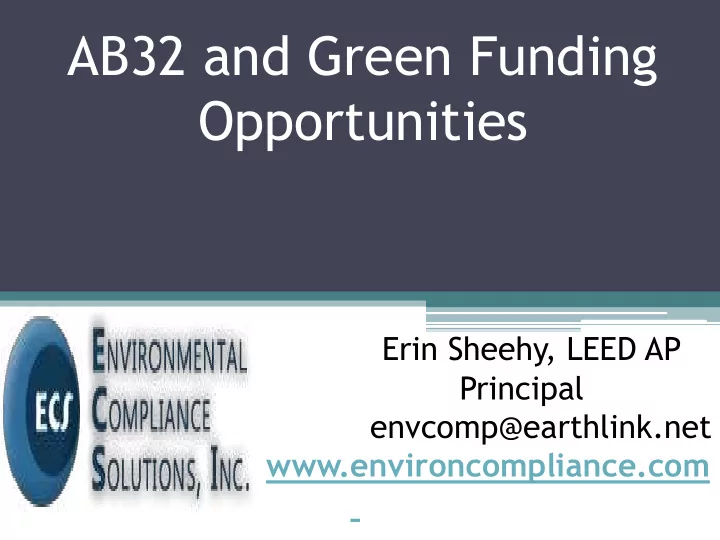

AB32 and Green Funding Opportunities Erin Sheehy, LEED AP Principal envcomp@earthlink.net www.environcompliance.com S
AB 32 Overview The Global Warming Solutions Act (AB32) was signed into law in 2006. This legislation requires greenhouse gas (GHG) emission reductions to 1990 levels by 2020. “Greenhouse gas” is a term that refers to the following: carbon dioxide (CO2), methane (CH4), nitrous oxide (N20), chloroflurocarbons (CFCs), and sulfur hexafluoride (SF6).
Sources of GHGs Source: CARB 1990 Inventory
AB 32 Overview Major stationary sources of CO2e (> 25,000 MTCO2e/ year) are currently regulated. Initial facility types include: refineries, power plants, landfills, and large industrial manufacturing operations. Each facility is issued an Emissions Allocation based on reported emissions. This allocation decreases annually (3% per year after 2015). One mechanism for complying with the decreasing allocation is through purchase of GHG offsets via the Cap and Trade program.
Cap-and-Trade Overview The Cap-and-Trade Program allows CARB and other organizations to verify GHG reductions from California projects. GHG offset credits are generated from those projects which yield permanent emission reductions in excess of any resulting from existing law. Those credits are then sold at auction to regulated entities.
Cap-and-Trade Overview Regulated entities can purchase offset credits at auction for up to 8% of their total emission allocation. Three California laws provide a mechanism for managing these monies by establishing the “Greenhouse Gas Reduction Fund.” These laws further outlined a framework for developing an Investment Plan for types of projects eligible for Cap-and- Trade funding. California’s Legislative Analyst’s Office estimates future potential GHG auction revenues of between $500 million - $3 billion per year .
Greenhouse Gas Reduction Fund ) SB 535 requires that projects in economically disadvantaged communities receive at least 25% of the total revenues . To meet this 25% benefit requirement, at least half of the census ZIP codes served by the project for which funding is being requested should be identified as disadvantaged communities. California disadvantaged communities are defined via a zip code list established by California Office of Environmental Health Hazard’s (OEHHA) California Communities Environmental Health Screening Tool (CalEnviroScreen)
Disadvantaged Communities )
Greenhouse Gas Reduction Fund Projects eligible for Greenhouse Gas Reduction Funding include, but are not limited to: - Mass Transit; - High Speed Rail (HSR); - Electrification of heavy duty and light duty vehicles; - Sustainable Communities and Infrastructure; - Advanced biofuels; - Energy Efficiency projects; - Distributed Renewable Energy; and - Electrification and Energy Projects assoc. with HSR
IMPORTANT NOTE This year’s revenues (approximately $500,000,000) have been borrowed by the Governor to pay for expenses in the general fund. These monies will not be available this year to offset costs associated with proposed GHG reduction projects. Plan for GHG FY 2014 or investigate numerous additional funding opportunities in the interim.
Other Funding Opportunities Numerous funding opportunities are available from Federal, State and local agencies. Department of Energy – Office of Energy Efficiency and Renewable Energy (EERE) and Clean Cities; http:/ / www1.eere.energy.gov/ cleancities/ Proposition 1B – Goods Movement Emission Reduction Program http http:/ / www.aqmd.gov/ tao/ Implementation/ Prop1B.htm Clean Transportation Funding – Mobile Source Air Pollution Reduction Committee (MSRC) http://www.cleantransportationfunding.org/
Other Funding Opportunities Additional Examples: AB 118 – CARB Air Quality Improvement Program (AQIP); http:/ / www.arb.ca.gov/ msprog/ aqip/ aqip.htm Air District Funding: Carl Moyer Program and AB2766 Funds; http:/ / www.aqmd.gov/ trans/ ab2766.html http:/ / www.arb.ca.gov/ msprog/ moyer/ moyer.htm South Coast Air Quality Management District – Technology Advancement Office http:/ / www.aqmd.gov/ tao/ Implementation
Further Action Items Review your agency’s capital projects for - potential funding applicability (either the GHG fund or others); - Track the development of the next California Investment Plan; - Submit comments to/ meet with CARB and other funding agencies to position your projects (January 2014 – on); - Review whether or not your serve disadvantaged communities; and - Review other grant opportunities.
Questions? Thank You. Erin Sheehy, LEED AP (626) 318-9567 envcomp@earthlink.net www.environcompliance.com S
Recommend
More recommend